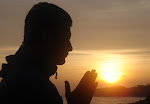What is your most challenging asana and why?
Padmasana - Lotus posture is the most challenging asana to me. In Sanskrit the word asana means to sit. I started practising asana when I was a kids and it was a fun to and at the same time challenging because my mother used to make me sit to settle me down - when I was naughty or during regular evening prayer. Padmasana is the first posture in my life. With the growth of time and age, it started blooming its petals, and it became more and more challenging to me.
What have you learned from this asana?
Like many other Indian kids, I started Padmasana out of fun during my childhood. That time it was not at all a challenging postures. It started becoming challenging when I actually started learning yogasanas. Bending the knees and dropping them on the ground, placing the heels close to the groin, keeping the spine straight , shoulders balanced but relaxed, grounding into Mother Earth, finding out the most centred balancing point of the body. This is the root of Muladhara Chakra and to generate the energy flow from that very point like the serpent standing up on its tail and opening up the Chakra one after the other - this is extremely challenging. Now in my 28 years of asana teaching life, it is another everyday challenging for me to make my students understand the beauty of a Lotus, the effect of keeping the spine straight, how it works on the knee joints and pelvis how to ground down on the hips and finding out the finer balancing point, and to explore the one lotus posture to hundreds of variations. Sitting quietly and settling down in this fast pace world is challenging and Padmasana is the tool to handle the challenging in both my student and teaching life.
What is the most challenging part of your practise?
The most challenging part of my practise is 'to be in the present moment'. I don't want to keep my Yoga practise confined to a 6" X 2" yoga mat. What you learn on the mat, if you cannot explore it off the mat, then it's useless. I understand the meaning of perseverance (practise) on the mat. The result is - success and the meaning of success changes in life, because it's relative. My challenge is to face that success. And that's what I am doing everyday.
Padmasana - Lotus posture is the most challenging asana to me. In Sanskrit the word asana means to sit. I started practising asana when I was a kids and it was a fun to and at the same time challenging because my mother used to make me sit to settle me down - when I was naughty or during regular evening prayer. Padmasana is the first posture in my life. With the growth of time and age, it started blooming its petals, and it became more and more challenging to me.
What have you learned from this asana?
Like many other Indian kids, I started Padmasana out of fun during my childhood. That time it was not at all a challenging postures. It started becoming challenging when I actually started learning yogasanas. Bending the knees and dropping them on the ground, placing the heels close to the groin, keeping the spine straight , shoulders balanced but relaxed, grounding into Mother Earth, finding out the most centred balancing point of the body. This is the root of Muladhara Chakra and to generate the energy flow from that very point like the serpent standing up on its tail and opening up the Chakra one after the other - this is extremely challenging. Now in my 28 years of asana teaching life, it is another everyday challenging for me to make my students understand the beauty of a Lotus, the effect of keeping the spine straight, how it works on the knee joints and pelvis how to ground down on the hips and finding out the finer balancing point, and to explore the one lotus posture to hundreds of variations. Sitting quietly and settling down in this fast pace world is challenging and Padmasana is the tool to handle the challenging in both my student and teaching life.
What is the most challenging part of your practise?
The most challenging part of my practise is 'to be in the present moment'. I don't want to keep my Yoga practise confined to a 6" X 2" yoga mat. What you learn on the mat, if you cannot explore it off the mat, then it's useless. I understand the meaning of perseverance (practise) on the mat. The result is - success and the meaning of success changes in life, because it's relative. My challenge is to face that success. And that's what I am doing everyday.
